Terminology of the British Isles: Difference between revisions
No edit summary |
No edit summary |
||
| Line 19: | Line 19: | ||
*Linguistic terms | *Linguistic terms | ||
**The United Kingdom and (the Republic of) Ireland | **The United Kingdom and (the Republic of) Ireland are referred to as ''countries'' or ''nations'' in formal documents while England, Wales, Scotland and (to a lesser extent) Northern Ireland can also be referred to as such. In everyday language the terms nation and country are used almost interchangeably. | ||
**British is an adjective pertaining to the United Kingdom; for example, a citizen of the UK is called a British citizen. | **British is an adjective pertaining to the United Kingdom; for example, a citizen of the UK is called a British citizen. | ||
**Wales is sometimes referred to as the 'Principality of Wales', or just 'the Principality', although this has no modern geographical or constitutional basis. | **Wales is sometimes referred to as the 'Principality of Wales', or just 'the Principality', although this has no modern geographical or constitutional basis. | ||
| Line 60: | Line 60: | ||
*The '''United Kingdom of Great Britain and Northern Ireland''', usually shortened to the '''United Kingdom''' (abbreviation '''UK'''), is Great Britain plus '''Northern Ireland''' since 1927. (The Partition of Ireland took place in 1922, but the consequent change in the official title of the UK was only made by Act of Parliament five years later.) The United Kingdom of Great Britain and Northern Ireland is often shortened to '''Britain''', even on official websites.<ref>{{cite web|url=http://www.direct.gov.uk/en/Gtgl1/GuideToGovernment/AboutBritain/index.htm |title=UK Government's "Guide to Government" |publisher=Direct.gov.uk |date= |accessdate=2010-06-19}}</ref><ref>{{cite web|url=http://www.statistics.gov.uk/lib2000/index.html |title=Office for National Statistics |publisher=Statistics.gov.uk |date= |accessdate=2010-06-19}}</ref> | *The '''United Kingdom of Great Britain and Northern Ireland''', usually shortened to the '''United Kingdom''' (abbreviation '''UK'''), is Great Britain plus '''Northern Ireland''' since 1927. (The Partition of Ireland took place in 1922, but the consequent change in the official title of the UK was only made by Act of Parliament five years later.) The United Kingdom of Great Britain and Northern Ireland is often shortened to '''Britain''', even on official websites.<ref>{{cite web|url=http://www.direct.gov.uk/en/Gtgl1/GuideToGovernment/AboutBritain/index.htm |title=UK Government's "Guide to Government" |publisher=Direct.gov.uk |date= |accessdate=2010-06-19}}</ref><ref>{{cite web|url=http://www.statistics.gov.uk/lib2000/index.html |title=Office for National Statistics |publisher=Statistics.gov.uk |date= |accessdate=2010-06-19}}</ref> | ||
:*The historical '''United Kingdom of Great Britain and Ireland''' was Great Britain plus Ireland, for the period 1801 to 1922, although the name change after the secession/independence of most of Ireland only took place in 1927. | :*The historical '''United Kingdom of Great Britain and Ireland''' was Great Britain plus Ireland, for the period 1801 to 1922, although the name change after the secession/independence of most of Ireland only took place in 1927. | ||
:N.B.: While "United Kingdom" is normally abbreviated '''UK''', the official ISO 3166 two-letter country code is '''GB''' and the three letter code is '''GBR''' (Ukraine has the two letter code UA and the three letter code UKR). Due to a pre-existing convention originating in the UK's JANET academic computer network,<ref>[http://www.mech-eng.leeds.ac.uk/www_vms/mail_changes.html "Electronic Mail address changes"] On the transition form big-endian to little-endian notation (Dept of Mechanical Engineering, The University of Leeds</ref> the UK's | :N.B.: While "United Kingdom" is normally abbreviated '''UK''', the official ISO 3166 two-letter country code is '''GB''' and the three letter code is '''GBR''' (Ukraine has the two letter code UA and the three letter code UKR). Due to a pre-existing convention originating in the UK's JANET academic computer network,<ref>[http://www.mech-eng.leeds.ac.uk/www_vms/mail_changes.html "Electronic Mail address changes"] On the transition form big-endian to little-endian notation (Dept of Mechanical Engineering, The University of Leeds</ref> the UK's Internet top-level domain is '''.uk''', a break from the practice of following ISO 3166 (a '''.gb''' domain has also been used to a limited extent in the past but is now defunct). '''GB''' was also used on car number plates to indicate the United Kingdom between 1910 and 2021. | ||
*'''Ireland''' (in Irish, '''''Éire''''') refers, geographically, to the island of Ireland, or to any of the following: | *'''Ireland''' (in Irish, '''''Éire''''') refers, geographically, to the island of Ireland, or to any of the following: | ||
| Line 149: | Line 149: | ||
[[File:British Isles United Kingdom.svg|left|80px]] | [[File:British Isles United Kingdom.svg|left|80px]] | ||
[[File:British Passport | [[File:British Passport 2020.png|180px|right|thumb|A British passport]] | ||
''The United Kingdom of Great Britain and Northern Ireland'' is the official full title of the state. This name appears on official documentation such as British passports. For convenience, the name is usually shortened to ''United Kingdom, UK'', ''Great Britain'' or ''Britain''.<ref name="autogenerated1"/> | ''The United Kingdom of Great Britain and Northern Ireland'' is the official full title of the state. This name appears on official documentation such as British passports. For convenience, the name is usually shortened to ''United Kingdom, UK'', ''Great Britain'' or ''Britain''.<ref name="autogenerated1"/> | ||
| Line 179: | Line 179: | ||
[[Image:Republic of Ireland.svg|left|80px]] | [[Image:Republic of Ireland.svg|left|80px]] | ||
[[Image:Eirepas.JPG|thumb| | [[Image:Eirepas.JPG|thumb|180px|An Irish passport]] | ||
Since the adoption of the Constitution of Ireland in 1937, '''Ireland''' has been the constitutional name of the state which covers approximately five-sixths of the island of Ireland. (Northern Ireland covers the remaining sixth of the island, in its north-east. Northern Ireland remains a constituent part of the United Kingdom.) | Since the adoption of the Constitution of Ireland in 1937, '''Ireland''' has been the constitutional name of the state which covers approximately five-sixths of the island of Ireland. (Northern Ireland covers the remaining sixth of the island, in its north-east. Northern Ireland remains a constituent part of the United Kingdom.) | ||
Latest revision as of 18:48, 5 January 2024
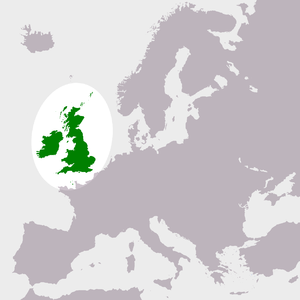
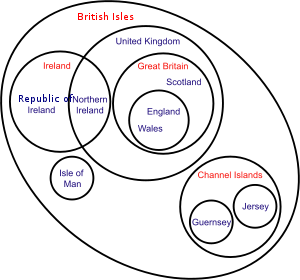
Various terms are used to describe the different (and sometimes overlapping) geographical and political areas of the islands of Great Britain, Ireland, and surrounding islands. The terminology is often a source of confusion, partly owing to the similarity between some of the actual words used, but also because they are often used loosely. The purpose of this article is to explain the meanings of and relationships among those terms.
In brief, the main terms and their simple explanations are as follows.
- Geographical terms:
- The British Isles is an archipelago consisting of the two large islands of Great Britain and Ireland, and many smaller surrounding islands.
- Great Britain is the largest island of the archipelago.[1][2][3]
- Ireland is the second largest island of the archipelago and lies directly to the west of Great Britain.
- The full list of islands in the British Isles includes over 1,000 islands,[4] of which 51 have an area larger than 20 km².
- Political terms
- The United Kingdom of Great Britain and Northern Ireland is the constitutional monarchy occupying the island of Great Britain, the small nearby islands (but not the Isle of Man or the Channel Islands), and the north-eastern part of the island of Ireland. Usually, it is shortened to United Kingdom, the UK, Great Britain or Britain.[5][6] The abbreviation GB is generally used for the United Kingdom of Great Britain and Northern Ireland in international agreements e.g. Universal Postal Union and Road Traffic Convention, as well as in the ISO 3166 country codes (GB and GBR).
- Ireland is the sovereign republic occupying the larger portion of the island of Ireland. However, to distinguish the state from the island it occupies the majority of, or to distinguish either of these from Northern Ireland, it is also called "the Republic of Ireland" or simply "the Republic". Periodically, its Irish-language name, Éire, will be used in an English-language context to distinguish it from "Northern Ireland", even though the word "Éire" directly translates as "Ireland".
- England and Wales, Scotland, and Northern Ireland are legal jurisdictions within the United Kingdom.
- Great Britain means the jurisdictions of England and Wales and Scotland considered as a unit.
- British Islands consists of the United Kingdom, the Channel Islands and the Isle of Man. These are the states within the British Isles that have the British monarch as head of state.
- Linguistic terms
- The United Kingdom and (the Republic of) Ireland are referred to as countries or nations in formal documents while England, Wales, Scotland and (to a lesser extent) Northern Ireland can also be referred to as such. In everyday language the terms nation and country are used almost interchangeably.
- British is an adjective pertaining to the United Kingdom; for example, a citizen of the UK is called a British citizen.
- Wales is sometimes referred to as the 'Principality of Wales', or just 'the Principality', although this has no modern geographical or constitutional basis.
- Northern Ireland can also be referred to, by those of a unionist persuasion, as the Province, in relation to its locality within the Province of Ulster.
- Sport
- The constituent parts of the United Kingdom often compete separately in international competition as nations (and can be described as "the home nations"). For example in association football, Scotland, Wales, Northern Ireland and England play as nations. An additional complication is that in some sports, such as rugby union, players from Northern Ireland and the Republic of Ireland play as one team, Ireland, in international competitions.
- Rugby union players from both Ireland and Great Britain play for British and Irish Lions representing the four "Home Unions" of England, Ireland, Scotland and Wales.
- Great Britain is often used to mean United Kingdom. Usually this is simply sloppy language, but it is sometimes used as an official shortening of United Kingdom of Great Britain and Northern Ireland. For example, at the Olympic Games, the team officially called "Great Britain" represents the political entity the United Kingdom, which includes Northern Ireland. The "Ireland" Olympic team represents the whole island of Ireland, a geographical entity. Athletes from Northern Ireland have the choice of participating in either the "Great Britain" team or the "Ireland" team.[7]
- In the majority of individual sports (e.g. tennis and athletics), at international level competitors are identified as GB if they are from Great Britain or Northern Ireland. A small number of sports (e.g. golf) identify participants as representing their constituent part of the UK. In the Commonwealth Games, England, Northern Ireland, Scotland and Wales each compete as separate nations, as do each of the three Crown Dependencies.
At a glance
Below is a visual reference guide to some of the main concepts and territories described in this article:
-
The British Isles
-
The British Islands
-
The Isle of Man
-
The Channel Islands (Jersey, Guernsey)
-
Ireland
-
The Republic of Ireland
-
The United Kingdom
-
Northern Ireland
-
Great Britain
-
England
-
Scotland
-
Wales
Terminology in detail
- Britain is a political and geographic term which can refer to the United Kingdom of Great Britain and Northern Ireland,[8] or sometimes the island of Great Britain.
- Great Britain is the largest island in Europe encompassing:
- England and Wales is a political and administrative term referring to England and Wales, which share the same legal system. Between 1746 and 1967 the term "England" did legally include Wales.
- England (see also the historical Kingdom of England).
- Wales (see also the historical Principality of Wales).
- Scotland (see also the historical Kingdom of Scotland)
- The historical Kingdom of Great Britain is Britain for the period 1707–1801.
- Britannia is the Roman province of Britain, or a poetic reference to later Britain, or a personification of Britain.
- The United Kingdom of Great Britain and Northern Ireland, usually shortened to the United Kingdom (abbreviation UK), is Great Britain plus Northern Ireland since 1927. (The Partition of Ireland took place in 1922, but the consequent change in the official title of the UK was only made by Act of Parliament five years later.) The United Kingdom of Great Britain and Northern Ireland is often shortened to Britain, even on official websites.[9][10]
- The historical United Kingdom of Great Britain and Ireland was Great Britain plus Ireland, for the period 1801 to 1922, although the name change after the secession/independence of most of Ireland only took place in 1927.
- N.B.: While "United Kingdom" is normally abbreviated UK, the official ISO 3166 two-letter country code is GB and the three letter code is GBR (Ukraine has the two letter code UA and the three letter code UKR). Due to a pre-existing convention originating in the UK's JANET academic computer network,[11] the UK's Internet top-level domain is .uk, a break from the practice of following ISO 3166 (a .gb domain has also been used to a limited extent in the past but is now defunct). GB was also used on car number plates to indicate the United Kingdom between 1910 and 2021.
- Ireland (in Irish, Éire) refers, geographically, to the island of Ireland, or to any of the following:
- Historically:
- The Kingdom of Ireland was Ireland for the period 1541-1801. (The King of Ireland remained Head of State in the Irish Free State and Ireland/Éire until the Republic of Ireland Act 1948 abolished that status).
- The Irish Republic, established by the Irish Declaration of Independence, was a 32-county republic encompassing the entire island, during the period 1919–22—though its de facto rule did not encompass all of the island. During this period, according to British law, Ireland remained part of the UK though its independence was recognised by Russia.
- Southern Ireland was a proposed Home Rule 26-county state under the Government of Ireland Act 1920. It never came into practical existence, being superseded by:
- The Irish Free State is Ireland excepting Northern Ireland during the period 1922-37.
- The terms Irish Republic, Southern Ireland, the Irish Free State and Éire (in English-language texts) have been used synonymously with the (Republic of) Ireland, although their use is inappropriate and potentially offensive if used today.
- However it has to be noted that as of 2010 on the BBC News website, the Republic of Ireland is still widely and almost exclusively referred to as the "Irish Republic".
- Present:
- Ireland (in Irish, Éire) is the political entity consisting of the island of Ireland excepting Northern Ireland, 1937-present. This is the name of the state according to the Irish Constitution.
- The Republic of Ireland a legal "description" of Ireland excepting Northern Ireland, 1949-present. This form is used where tact or disambiguity demands. It is also the name used by the international Association Football team.
- Northern Ireland 1922-present. That part of the island of Ireland north of the line of partition of 1922, and which is still part of the United Kingdom. It is sometimes referred to as "the North of Ireland", "the Six Counties" or (in extremist usage) the "occupied six counties", especially by Irish Nationalists.
- Ulster The name of one of Ireland's four traditional provinces. The area contains the nine northernmost counties, six of which make up Northern Ireland, and three of which are part of the Republic of Ireland. It is also often used to refer to the smaller Northern Ireland. Though Ulster has not been a political entity since the ancient Gaelic provincial Kingdoms, it remains associated with a geographical area and is used in sporting and cultural contexts.
- In sport
- In Gaelic games, no distinction is recognised between the counties of the Republic and those of Northern Ireland. County teams play in their provincial championships (where the six counties of Ulster within Northern Ireland and three within the Republic all play in the Ulster championship) and the winners of these play in the All-Ireland championship (which has been recently complicated by the introduction of a back-door system). Even within Northern Ireland, a tricolour, the flag of the Republic of Ireland, is flown at all games. At bigger games, where an anthem is played, it is always the national anthem of the Republic. In the case of the International Rules series against Australia, an Irish national team is chosen from all thirty-two counties.
- In Association Football, the teams correspond to political entities: Northern Ireland and the Republic of Ireland. In accordance with UEFA and FIFA's rules, each of these countries has its own football league: the Irish League and the League of Ireland respectively.
- In rugby union, rugby league, field hockey , cricket, boxing, golf, athletics and others the Ireland team is drawn from the whole island (ie. both the Republic and Northern Ireland). Many sports organisations are subdivided along provincial lines e.g. Gaelic Athletic Association, golf.
- The British Isles is a term used to mean the island of Great Britain plus the island of Ireland and many smaller surrounding islands, including the Isle of Man and, in some contexts, the Channel Islands (Guernsey and Jersey).
- Great Britain and Ireland, or variants like "Britain and Ireland" or "The UK and Ireland" are sometimes used as alternatives to the term British Isles.
- Anglo-Celtic Isles is an alternative term (in limited use) for the geographic region comprising Britain & Ireland, more commonly referred to as the 'British Isles'. 'Anglo-Celtic Islands' is a derivative of this. It is intended as a geographic term free of any political implication and uses the macro-cultural grouping term Anglo-Celtic, referring to the peoples from which the majority of the island group's population are descended—the Anglo-Saxons and the Celts (it can also be inclusive of the Anglo-Normans).
- Islands of the North Atlantic is another suggested replacement term for 'British Isles', without the same political connotations. However, its convolution and impracticality due to implying inclusion of fellow North Atlantic islands such as Iceland have made it unworkable and it has not come into common use. The term was used as part of the Strand 3 level of negotiations for the Belfast agreement. (Its acronym, IONA, is also the name of the small but historically important island of Iona off the coast of Scotland.)
- British Islands (a legal term not in common usage) is the UK, the Isle of Man, and the Channel Islands.
- Brittany, itself a corruption of 'Britain', and sometimes formerly known as 'Little Britain' is a historical Duchy in the West of France, now a French region.
Geographical distinctions
The British Isles
Great Britain

|
Great Britain refers to the largest of the British Isles. In present the sense of the word "Great" means "larger" in contrast to Brittany in modern-day France. A historical term for a peninsula in France that largely corresponds to the modern French province is Lesser or Little Britain. That region was settled by many British immigrants during the period of Anglo-Saxon migration into Britain, and named "Little Britain" by them. The French term "Bretagne" now refers to the French "Little Britain", not to the British "Great Britain", which in French is called Grande-Bretagne. In classical times, the Roman geographer Ptolemy in his Almagest also called the larger island Megale Brettania (Great Britain). At that time, it was in contrast to the smaller island of Ireland, which he called Mikra Brettania (Little Britain). In this later work, Geography, Ptolemy refers to Great Britain as Albion and to Ireland as Iwernia. These "new" names were likely to have been the native names for the islands at the time. The earlier names, in contrast, were likely to have been coined before direct contact with local peoples were made.[12] |
Scotland
England
Wales
Ireland
Isle of Man
Channel Islands
Political distinctions
The United Kingdom

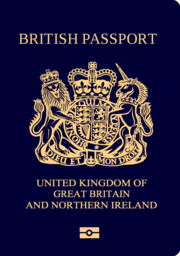
The United Kingdom of Great Britain and Northern Ireland is the official full title of the state. This name appears on official documentation such as British passports. For convenience, the name is usually shortened to United Kingdom, UK, Great Britain or Britain.[6]
The United Kingdom is a sovereign state. Wales can also be described as a principality of the United Kingdom (Prince of Wales is a title usually given to the heir apparent to the British throne but has no political or other role in respect of Wales). Northern Ireland is sometimes described by United Kingdom citizens as a province of the United Kingdom, which derives from the province of Ulster, of which Northern Ireland is part. Northern Ireland also had, until 1972, a far greater degree of self-government than the other constituent parts of the UK.
Great Britain is both a geographical and a political entity. Geographically, it is one island, but politically it also contains the surrounding islands, notably Anglesey, the Isle of Wight, the Inner Hebrides, Outer Hebrides, Orkney Islands and Shetland Islands).
The abbreviation GB is sometimes officially used for the United Kingdom, for example in the Olympics, or as the vehicle registration plate country identification code for UK-registered cars between 1910 and 2021.
The internet code ".gb", although allocated to the UK, is virtually unused and UK domains use ".uk".
The four constituent parts of the UK are also known to some as Home Nations or the "Four Nations". The BBC refers to its regional broadcasting operation as Nations and Regions [13] ("regions" referring to the Regions of England).
In sport, England, Wales, Scotland, Northern Ireland have their own separate national teams in certain sports - for example in association football. Sporting contests between them are known as "Home internationals" (an example is the British Home Championship in football).
The governing body for football in Northern Ireland is called the Irish Football Association, having been in existence since some forty years before partition. Its counterpart in the Republic (plus Derry City FC) is the Football Association of Ireland. The Northern Ireland national team retained the name "Ireland" for some fifty years after partition. Since around 1970 the two teams have been consistently referred to as "Northern Ireland" and "Republic of Ireland" respectively.
UK teams in the Olympics have competed under several different names - for instance in Beijing the athletes were presented at the Opening Ceremony under a banner which said simply Great Britain, rather than the full Great Britain and Northern Ireland. Olympic athletes from Northern Ireland may choose whether to represent the UK or Ireland.
Since the Good Friday Agreement, and the subsequent implementation legislation, sporting organisation (and several other organisations, e.g. tourism, Irish Gaelic and Ulster Scots language boards) on the island of Ireland has increasingly been cross-border.
Citizens of the UK are called British or Britons. The term Brits may also be used, sometimes pejoratively. Some older slang names for Britons are Tommy (for British soldiers), Anglo and Limey. Anglo properly refers only to England, but it is sometimes used as a broader reference as an element in compound adjectives: for example, "Anglo-French relations" may be used in newspaper articles when referring to relations between the political entities France and the United Kingdom. Anglo-Saxon may be used (particularly in Continental European languages) when referring to the whole English-speaking world, the Anglosphere, although ethnically very few of the world's one thousand million English-speakers are of Anglo-Saxon origin.
Ireland

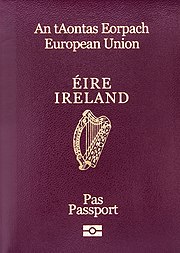
Since the adoption of the Constitution of Ireland in 1937, Ireland has been the constitutional name of the state which covers approximately five-sixths of the island of Ireland. (Northern Ireland covers the remaining sixth of the island, in its north-east. Northern Ireland remains a constituent part of the United Kingdom.)
Since the Republic of Ireland Act 1948, the term "Republic of Ireland" is the term used as the additional description of the state. This term is useful in avoiding ambiguity between the name of the island and the name of the state. However, the term "Ireland" is always used in formal diplomatic contexts such as the European Union or the United Nations. The passport of the Republic of Ireland bears the name Éire - Ireland.
Before the introduction of the 1937 constitution and the new name, the Irish Free State occupied the same territory as the modern state of Ireland. The Irish Free State became an autonomous dominion of the British Empire in 1922 when it seceded from the United Kingdom through the Anglo-Irish Treaty. The King ceased to be its Head of State in 1936 and the state ceased to be a Dominion and left the Commonwealth in 1948.
Traditionally, the island of Ireland is divided into four provinces - Leinster, Connacht, Munster and Ulster, with each of the provinces further divided into counties. The Republic of Ireland takes up 83% of the island, and twenty-six of the thirty-two traditional counties of Ireland. Northern Ireland takes up the remaining area and six of the traditional nine counties of Ulster, although these counties no longer exist as official administrative units.
On the island of Ireland the naming of places often raises political issues. The usage of "Ireland" as the official name of the state causes offence to some Unionists in Northern Ireland, who believe it implies that the state still has a territorial claim to the whole island - the terminology of "Republic of Ireland" or "Éire" is much preferred by Northern Irish unionists when referring to that political state. Similarly, some Nationalists in Northern Ireland also prefer to reserve the usage of "Ireland" to refer to the whole island.
In Northern Ireland, Irishness is a highly contested identity, with fundamentally different perceptions between unionists who perceive themselves as being both British and Irish, and nationalists who consider both communities to be part of the Irish nation.[14]
The Republic of Ireland is often referred to by the Nationalist and Republican communities by the term "the Twenty-six Counties", with the connotation that the state constituted as such forms only a portion of the ideal political unit of the Irish Republic, which would consist of all of the thirty-two counties into which the island is divided. Additionally, the term "the Six Counties" (in reference to Northern Ireland's six counties) is also used. Other Nationalist terms in use include: "the occupied six counties", but more popularly, "the North of Ireland" and, "the North", these are terms also used by the Irish national broadcaster RTÉ.
The Irish passport is available to Irish citizens and can also be applied for abroad through Irish Consular services and the local Irish Embassy. As per the Irish nationality law, any person born on the island of Ireland before 2005, or otherwise a first generation descendant of such a person, is allowed to apply for an Irish passport. As such, people born in Northern Ireland and their children may be Irish citizens and hold an Irish passport if they choose.
Ulster
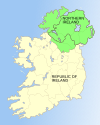
The terminology and usage of the name Ulster in Irish and British culture varies. Many within the unionist community refer to Northern Ireland as Ulster – although this is officially wrong, as the Irish province of Ulster is a nine-county entity incorporating the three counties of Donegal, Cavan and Monaghan, which are in the Republic of Ireland, along with the six counties of Northern Ireland. The term Ulster (and "the Province") are sometimes preferred by Unionists, sometimes because it can suggest an origin of the polity of Northern Ireland that pre-dates 1922, referring back to the Act of Union 1800, the Glorious Revolution of 1689, the Plantation of Ulster in 1610, the ancient migrations between Ulster and Scotland, and even to biblical tradition. This use for the term Ulster by Unionists to mean Northern Ireland, is perceived as offensive by some members of the Nationalist community, as Ulster includes, but is not exclusive, to Northern Ireland. Certain local place names are also still disputed, Derry/Londonderry for example.
British Islands

Under the Interpretation Act 1978 of the United Kingdom, the legal term British Islands (as opposed to the geographical term British Isles) refers to the United Kingdom of Great Britain and Northern Ireland, together with the Crown dependencies: the Bailiwicks of Jersey and of Guernsey (which in turn includes the smaller islands of Alderney, Herm and Sark) in the Channel Islands; and the Isle of Man. On the front of passports issued to residents of the Crown dependencies, the words "United Kingdom of Great Britain and Northern Ireland" are replaced with "British Islands" followed by the name of the issuing state or island.[15]
Historical aspects
Origins of terms
The earliest known names for the islands come from ancient Greek writings. Though the original texts have been lost, excerpts were quoted or paraphrased by later authors. Parts of the Massaliote Periplus, a merchants' handbook describing searoutes of the 6th century BC, were used in translation in the writings of Avienus around AD 400. Ireland was referred to as Ierne (Insula sacra, the sacred island, as the Greeks interpreted it) "inhabited by the race of Hiberni" (gens hiernorum), and Britain as insula Albionum, "island of the Albions".[16] Several sources from around 150 BC to AD 70 include fragments of the travel writings of the ancient Greek Pytheas around 320 BC, which also used the terms "Albion and 'Ierne."[17] and have been described as referring to the British Isles, including Ireland, as the Pretanic Islands.[18] Greek writers used the term αι Βρεττανιαι, which has been translated as the Brittanic Isles, and the peoples of these islands of Prettanike were called the Πρεττανοι, Priteni or Pretani.[16] These names derived from a "Celtic language" term which is likely to have reached Pytheas from the Gauls[18] who may have used it as their term for the inhabitants of the islands.[19]
The Romans called the inhabitants of Gaul (modern France) Galli or Celtae. The latter term came from the Greek name Κελτοι for a central European people, and 17th century antiquarians who found language connections developed the idea of a race of Celts inhabiting the area, but this term was not used by the Greeks or Romans for the inhabitants of Britain or Ireland,[20] nor is there any record of the inhabitants of the British Isles referring to themselves as such. Nevertheless, Roman administration would later incorporate the province of Britannia into the praetorian prefecture of Gaul, in common with Hispania, which had Celtiberians. Armorica, where the Bretons would settle, was part of Gallia Celtica, so there were tertiary relations between the Britons and Gallic Celts at least. In addition, the Parisii of Gallia Celtica are thought to have founded Aldborough in Britain. Belgae and Silures also came from Gallic areas, although not strictly "Celtic", but from Gallia Belgica and Aquitainia.
Priteni is the source of the Welsh language term Prydain, Britain,[18] and has the same source as the Goidelic term Cruithne. The latter referred to the early Brythonic-speaking inhabitants of the Scottish highlands and the north of Scotland,[18] who are known as the Cruithne in Scottish Gaelic, and who the Romans called Picts or Caledonians.
Romans
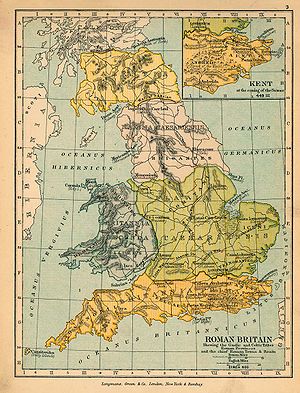
Caesar's invasions of Britain brought descriptions of the peoples of what he called Britannia pars interior, "inland Britain", in 55 BC. Throughout Book 4 of his Geography, Strabo is consistent in spelling the island Britain (transliterated) as Prettanikee; he uses the terms Prettans or Brettans loosely to refer to the islands as a group - a common generalisation used by classical geographers. For example, in Geography 2.1.18, …οι νοτιώτατοι των Βρεττανών βορειότεροι τούτων εισίν ("…the most southern of the Brettans are further north than this").[21] He was writing around AD 10, although the earliest surviving copy of his work dates from the 6th century. Pliny the Elder writing around AD 70 uses a Latin version of the same terminology in section 4.102 of his Naturalis Historia. He writes of Great Britain: Albion ipsi nomen fuit, cum Britanniae vocarentur omnes de quibus mox paulo dicemus. ("Albion was its own name, when all [the islands] were called the Britannias; I will speak of them in a moment"). In the following section, 4.103, Pliny enumerates the islands he considers to make up the Britannias, listing Great Britain, Ireland, and many smaller islands. In his Geography written in the mid 2nd century and probably describing the position around AD 100,[18] Ptolemy includes both Britain and Ireland – he calls it Hibernia – in the island group he calls Britannia. He entitles Book II, Chapter 1 of as Hibernia, Island of Britannia, and Chapter 2 as Albion, Island of Britannia.[22]
The name Albion for Great Britain fell from favour, and the island was described in Greek as Πρεττανία or Βρεττανία, in Latin Britannia, an inhabitant as Βρεττανός, Britannus, with the adjective Βρεττανικός, Britannicus, equating to "British".[16] With the Roman conquest of Britain the name Britannia was used for the province of Roman Britain. The Emperor Claudius was honoured with the agnomen Britannicus as if he were the conqueror, and coins were struck from AD 46 inscribed DE BRITAN, DE BRITANN, DE BRITANNI, or DE BRITANNIS. With the visit of Hadrian in AD 121 coins introduced a female figure with the label BRITANNIA as a personification or goddess of the place. These and later Roman coins introduced the seated figure of Britannia which would be reintroduced in the 17th century.[23]
In the later years of Roman rule Britons who left Latin inscriptions, both at home and elsewhere in the Empire, often described themselves as Brittanus or Britto, and where describing their citizenship gave it as cives of a British tribe or of a patria (homeland) of Britannia, not Roma.[16] From the 4th century, many Britons migrated from Roman Britain across the English Channel and founded Brittany.
Mediæval period
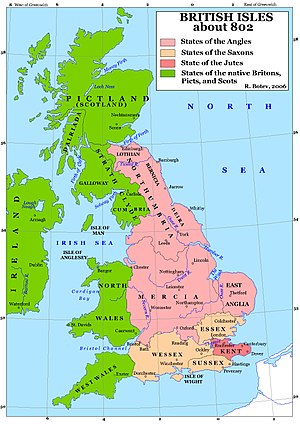
While Latin remained the language of learning, from the early mediæval period records begin to appear in native languages. The earliest indigenous source to use a collective term for the archipelago is the Life of Saint Columba, a hagiography recording the missionary activities of the sixth century Irish monk Saint Columba among the peoples of what is now Scotland. It was written in the late seventh century by Adomnán of Iona, an Irish monk living on the Inner Hebridean island. The collective term for the archipelago used within this work is Oceani Insulae meaning "Islands of the Ocean" (Book 2, 46 in the Sharpe edition = Book 2, 47 in Reeves edition), it is used sparingly and no Priteni-derived collective reference is made.
Another early native source to use a collective term is the Historia ecclesiastica gentis Anglorum of Bede written in the early eighth century. The collective term for the archipelago used within this work is insularum meaning "islands" (Book 1, 8) and it too is used sparingly. He stated that Britain "studies and confesses one and the same knowledge of the highest truth in the tongues of five nations, namely the Angles, the Britons, the Scots, the Picts, and the Latins", distinguishing between the Brythonic languages of the "ancient Britons" or Old Welsh speakers and other language groups.[24]
Early Celtic, Saxon and Viking kingdoms such as Rheged, Strathclyde and Wessex amalgamated, leading to the formation of Scotland, England and Wales. In Norman Ireland, local lords gained considerable autonomy from the Lordship of Ireland until it became the Kingdom of Ireland under direct English rule.
Renaissance mapmakers
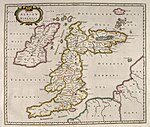
Abraham Ortelius makes clear his understanding that England, Scotland and Ireland were politically separate in 1570 by the full title of his map: "Angliae, Scotiae et Hiberniae, sive Britannicar. insularum descriptio" which translates as "A representation of England, Scotland and Ireland, or Britannica's islands." Additionally many maps from this period show Wales and Cornwall as separate nations, most notably those of Mercator.
Maps of the Mediæval, Renaissance and later periods often referred to Albion. This archaic term was originally used by Ptolemy and Pliny to mean the island of Great Britain. In later centuries its meaning changed to refer only to the area we now call Scotland (Albany, or Alba in Gaelic). Albion has survived as a poetic name for Britain but it is not in everyday use.
18th and 19th Centuries
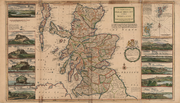
Following the Acts of Union 1707, a fashion arose, particularly in Scotland, for referring to Scotland and England as North Britain and South Britain respectively. These terms gained in popularity during the nineteenth century. The most lasting example of this usage was in the name of the North British Railway, which became part of the London and North Eastern Railway in 1923, and in the name of the North British Hotel, built by the railway in Edinburgh in 1902, which retained the name until it reopened in 1991 as the Balmoral Hotel.
Evolution of kingdoms and states
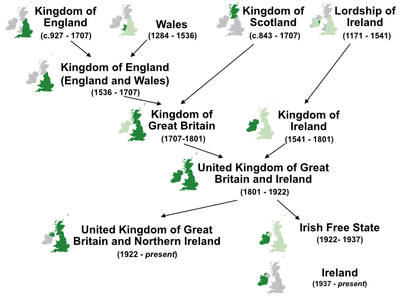
The diagram on the right gives an indication of the further evolution of kingdoms and states. In 1603 the Scottish King James VI inherited the English throne as "James I of England". He styled himself as James I of Great Britain, although both states retained their sovereignty and independent parliaments, the Parliament of Scotland and the Parliament of England. (The term "Great Britain" itself reportedly dates from as early as 1474, and was in common usage from the mid-16th century onwards.[25])
The 1707 Act of Union united England and Scotland in the United Kingdom of Great Britain under the Parliament of Great Britain, then in 1800 Ireland was brought under British government control by the Act of Union 1800 creating the United Kingdom of Great Britain and Ireland. Irish unrest culminated in the Irish War of Independence and the 1922 separation of the Irish Free State, which later became a republic with the name Ireland. The majority northeast continued to be part of what became the United Kingdom of Great Britain and Northern Ireland.
British overseas territories such as Bermuda, Gibraltar, Hong Kong, the Falkland Islands, and the British Antarctic Territory have (or have had) various relationships with the UK. The Commonwealth of Nations, initially formalised in 1931 (the British Commonwealth until 1949), is an association of independent states roughly corresponding to the former British Empire. (This has no connection with the Commonwealth of England, a short-lived republic replacing the previous kingdoms during the English Interregnum (1649–1660).)
Adjectives
In the absence of a single adjective to refer to the United Kingdom, British is generally used to refer to the United Kingdom as a whole. However, in a specifically physical geographical sense, British is used to refer to the island of Great Britain. Members of the Unionist communities in Northern Ireland might describe themselves as British even though they are not on the island of Great Britain, as this reflects a political and cultural identity.
The cumbersome adjective Great British is very rarely used to refer to Great Britain, other than to contrive a pun on the word great, as in "Great British Food".
Irish, in a political sense, is used to refer to the Republic of Ireland. Northern Ireland, as a constituent part of the United Kingdom, would be included within the umbrella of the political term British, though many Unionists in Northern Ireland also consider themselves Irish. In order to be more specific, Northern Irish is therefore in common usage. Members of the Nationalist communities would not describe themselves as British and would only use the terms Irish, or specifically Northern Irish where needed.
The term Ulster can also be used as an adjective (e.g. "Royal Ulster Constabulary"), but this is more likely to be used by Unionists and has political connotations in the same fashion as its use as a proper noun (because only six of the traditional nine counties of Ulster, namely Antrim, Armagh, Down, Fermanagh, Londonderry and Tyrone, are included in Northern Ireland with the remaining three counties Cavan, Donegal and Monaghan forming part of the Republic). The term Ulsterman (or Ulsterwoman) is common and holds no such political connotation. Likewise, Irish Nationalists might describe, say, a lake in Northern Ireland as Irish. However, some Nationalists might attribute what they see as less attractive aspects of Northern Ireland to Britain or even to England.
Note that the geographical term Irish Sea thus far appears to have escaped political connotations, even though territorial control of the waters of the Irish Sea is divided between both the Republic of Ireland and the UK, and also includes a British Crown dependency, the Isle of Man—as yet there appears to be no controversy with the term’s usage to mirror that of "British Isles". The North Channel is found off the east coast of Northern Ireland and it stretches the length of roughly two-thirds of Northern Ireland's eastern coastline.
The "Northern" in "Northern Ireland" is not completely accurate. The most northerly point on the island, Malin Head, is in the Republic of Ireland — in County Donegal's Inishowen Peninsula.
Scottish, English and Welsh are self-explanatory but the term English is often incorrectly used to mean British as well.[26] Americans and Europeans often use the term in this fashion.
Further information
Isle of Man and Channel Islands
The Isle of Man and the two bailiwicks of the Channel Islands are Crown dependencies; that is, non-sovereign nations, self-governing but whose sovereignty is held by the British Crown. They control their own internal affairs, but not their defence or foreign relations. They are not part of the United Kingdom nor part of the European Union.
- The Isle of Man is part of the British Isles, situated in the Irish Sea between Great Britain and Ireland.
- The Channel Islands consist politically of two self-governing bailiwicks: the Bailiwick of Guernsey and the Bailiwick of Jersey. They are the remnants of the Duchy of Normandy, which was once in personal union with the Kingdom of England. They are sometimes, despite their location next to mainland France, considered part of the British Isles. This usage is political rather than geographic.
- The Isle of Man and the Channel Islands are British Islands in United Kingdom law.
Celtic names
There are five living Celtic languages in the region. Each have names for the islands and countries of the British Isles. They are divided into two branches:
- Brythonic – which includes Welsh and Cornish
- Goidelic – which includes Irish, Scottish Gaelic and Manx
Some of the above are:
| English | Cornwall | Wales | Ireland | Northern Ireland |
Republic of Ireland |
Scotland | Mann | England |
|---|---|---|---|---|---|---|---|---|
| Cornish (Kernewek) |
Kernow | Kembra | Iwerdhon | Iwerdhon Gledh | Repoblek Iwerdhon |
Alban | Manow | Pow an Sawson |
| Welsh (Cymraeg) |
Cernyw | Cymru | Iwerddon | Gogledd Iwerddon | Gweriniaeth Iwerddon |
Yr Alban | Manaw | Lloegr |
| Irish (Gaeilge) |
an Chorn | an Bhreatain Bheag | Éire | Tuaisceart Éireann | Poblacht na hÉireann |
Albain | Manainn | Sasana |
| Scottish Gaelic (Gàidhlig) |
a' Chòrn | a' Chuimrigh | Èirinn | Èirinn a Tuath | Poblachd na h-Èireann |
Alba | Manainn | Sasainn |
| Manx (Gaelg) |
yn Chorn | Bretyn Beg | Nerin | Nerin Twoaie | Pobblaght Nerin |
Nalbin | Mannin | Sostyn |
Note: In Irish there are actually several terms for Northern Ireland: An Tuaisceart, meaning "the North", is usually used, but a more recent term for official use is Tuaisceart Éireann.
The English word Welsh is from a common Germanic root meaning "foreigner" (cognate with Wallonia and Wallachia, and also cognate with the word used in Mediaeval German to refer to the French and Italians). The English names Albion and Albany are related to Alba and used poetically for either England or Scotland, or the whole island of Great Britain. English Erin is a poetic name for Ireland derived from Éire (or rather, from its dative form Éirinn).
The terms for the British Isles in the Irish language
In Irish, the term Oileáin Bhriotanacha is attested as a version of the English term British Isles.[27] In this sense, Briotanach refers to British people in the sense of the islands belonging to them. Another translation is Oileáin Bhreataineacha, which is used in a 1937 geography book translated into Irish from English.[28] In this instance, Breataineach refers to the people of the island of Great Britain, again in the sense of the islands belonging to them. Neither of these two terms is often used in Irish.[29]
Earlier dictionaries[30] give Oileáin Iarthair Eorpa as the translation, literally meaning West European Isles. Today the most common term Éire agus an Bhreatain Mhór is used, meaning literally as Ireland and Great Britain, as provided by terminological dictionaries.[31]
Slang
Blighty is a slang word for Britain derived from the Hindustani word bilāyatī ("foreign"). Depending on the user, it is meant either affectionately or archly. It was often used by British soldiers abroad in the First World War to refer to home.
Europe
The term "Europe" may be used in one of several different contexts by British and Irish people; either to refer to the whole of the European continent, to refer to only to Mainland Europe, sometimes called "continental Europe" or simply "the Continent" by some people in the archipelago—as in the apocryphal newspaper headline "Fog shrouds Channel, continent cut off."
Europe and the adjective European may also be used in reference to the European Union, particularly in a derogative context such as "The new regulations handed out by Europe".
References
- ↑ "Britain", Oxford English Dictionary: "More fully Great Britain. As a geographical and political term: (the main island and smaller offshore islands making up) England, Scotland, and Wales, sometimes with the Isle of Man"
- ↑ New Oxford American Dictionary: "Britain: an island that consists of England, Wales, and Scotland. The name is broadly synonymous with Great Britain, but the longer form is more usual for the political unit."
- ↑ "Britain", Oxford English Dictionary (Online Edition): "Britain: 1a - The proper name of the whole island containing England, Wales, and Scotland, with their dependencies; more fully called Great Britain; now also used for the British state or empire as a whole."
- ↑ The are no official definitions, but Scotland has over 790 offshore islands - see Haswell-Smith, Hamish (2004). The Scottish Islands. Edinburgh: Canongate. ISBN 1-84195-454-3. plus numerous freshwater islands so a complete list of the British Isles would probably have between 1,000 and 2,000 entries.
- ↑ Guardian Unlimited Style Guide, Guardian News and Media Limited, 2007
- ↑ 6.0 6.1 "Great Britain", New Oxford American Dictionary: "Great Britain: England, Wales, and Scotland considered as a unit. The name is also often used loosely to refer to the United Kingdom."
- ↑ "BBC SPORT | Athletics | Nine NI athletes in Irish squad". BBC News. 2007-06-14. http://news.bbc.co.uk/sport2/low/athletics/6754181.stm. Retrieved 2010-01-24.
- ↑ "the term 'Britain' is used informally to mean the United Kingdom of Great Britain and Northern Ireland" — quote from British Government website
- ↑ "UK Government's "Guide to Government"". Direct.gov.uk. http://www.direct.gov.uk/en/Gtgl1/GuideToGovernment/AboutBritain/index.htm. Retrieved 2010-06-19.
- ↑ "Office for National Statistics". Statistics.gov.uk. http://www.statistics.gov.uk/lib2000/index.html. Retrieved 2010-06-19.
- ↑ "Electronic Mail address changes" On the transition form big-endian to little-endian notation (Dept of Mechanical Engineering, The University of Leeds
- ↑ Philip Freeman, Ireland and the Classical World, University of Texas Press, 2001
- ↑ BBC Press Office. "BBC Nations & Regions". http://www.bbc.co.uk/pressoffice/keyfacts/stories/nationsregions.shtml.
- ↑ CAIN: Democratic Dialogue: With all due respect - pluralism and parity of esteem (Report No. 7) by Tom Hennessey and Robin Wilson, Democratic Dialogue (1997)
- ↑ "States of Guernsey passports". Guernsey Government Website. http://www.gov.gg/ccm/navigation/home-department/customs---excise--immigration---nationality-service/passports2/.
- ↑ 16.0 16.1 16.2 16.3 Snyder, Christopher A. (2003). The Britons. Blackwell Publishing. ISBN 0-631-22260-X.
- ↑ "Entry for Albion a 1911 Encyclopedia". Historymedren.about.com. 2010-06-14. http://historymedren.about.com/od/aentries/a/11_albion.htm. Retrieved 2010-06-19.
- ↑ 18.0 18.1 18.2 18.3 18.4 Foster (editor), R F; Donnchadh O Corrain, Professor of Irish History at University College Cork: (Chapter 1: Prehistoric and Early Christian Ireland) (1 November 2001). The Oxford History of Ireland. Oxford University Press. ISBN 0-19-280202-X.
- ↑ Encyclopedia of the Celts: Pretani
- ↑ "The earliest Celts in Europe". WalesPast. http://www.walespast.com/article.shtml?id=36. Retrieved 2010-06-19.
- ↑ Translation by Roseman, op.cit.
- ↑ Ptolemy's Geography
- ↑ Britannia on Roman Coins, Roman coins in Britain
- ↑ General survey of Lothian
- ↑ Royal Styles and Titles in England and Great Britain, heraldica.org
- ↑ "The majority of English people still behave as if 'English' and 'British' are synonymous", historian Norman Davies quoted in The English: Europe's lost tribe, BBC News Story, January 14, 1999
- ↑ For example on english-irishdictionary.com.
- ↑ Tír-Eóluíocht na h-Éireann ('The Geography of Ireland') by T. J. Dunne, translated by Toirdhealbhach Ó Raithbheartaigh, Government Publications Office, Dublin
Tá Éire ar cheann de na h-oileáin a dtugar na h-Oileáin Bhreataineacha ortha agus atá ar an taobh Thiar-Thuaidh de'n Eóraip. Tá siad tuairim a's ar chúig mhíle oileán ar fad ann. (Oileánradh an t-ainm a bheirtear ar áit ar bith i n-a bhfuil a lán oileán agus iad i n-aice a chéile mar seo.) Éire agus an Bhreatain Mhór (Sasain, an Bhreatain Bheag, agus Alba) an dá oileán is mó de na h-Oileáin Bhreataineacha.
Ireland is one of the islands which are called the British Isles and which are on the North-Western side of Europe. It is thought that there are five thousand islands in total there. (Archipelago is the name which is borne by a place in which there are many islands next to each other like these.) Ireland and Great Britain (England, Wales, and Scotland) are the two largest islands of the British Isles.
- ↑ See for example Google searches for Oileáin Bhriotanacha (less references to the British Virgin Isles) or Oileáin Bhreataineacha, which produces only mirrors of Wikipedia.
- ↑ Patrick S. Dineen, Foclóir Gaeilge Béarla, Irish-English Dictionary, Dublin, 1927
- ↑ focail.ie, "The British Isles", Foras na Gaeilge, 2006


















